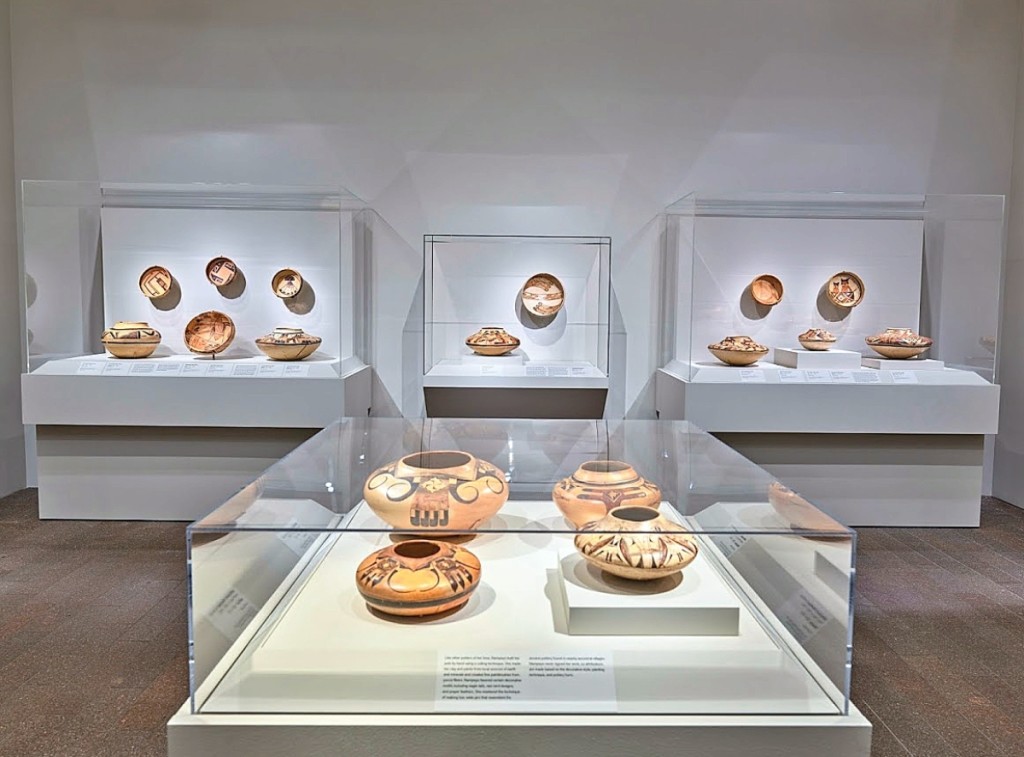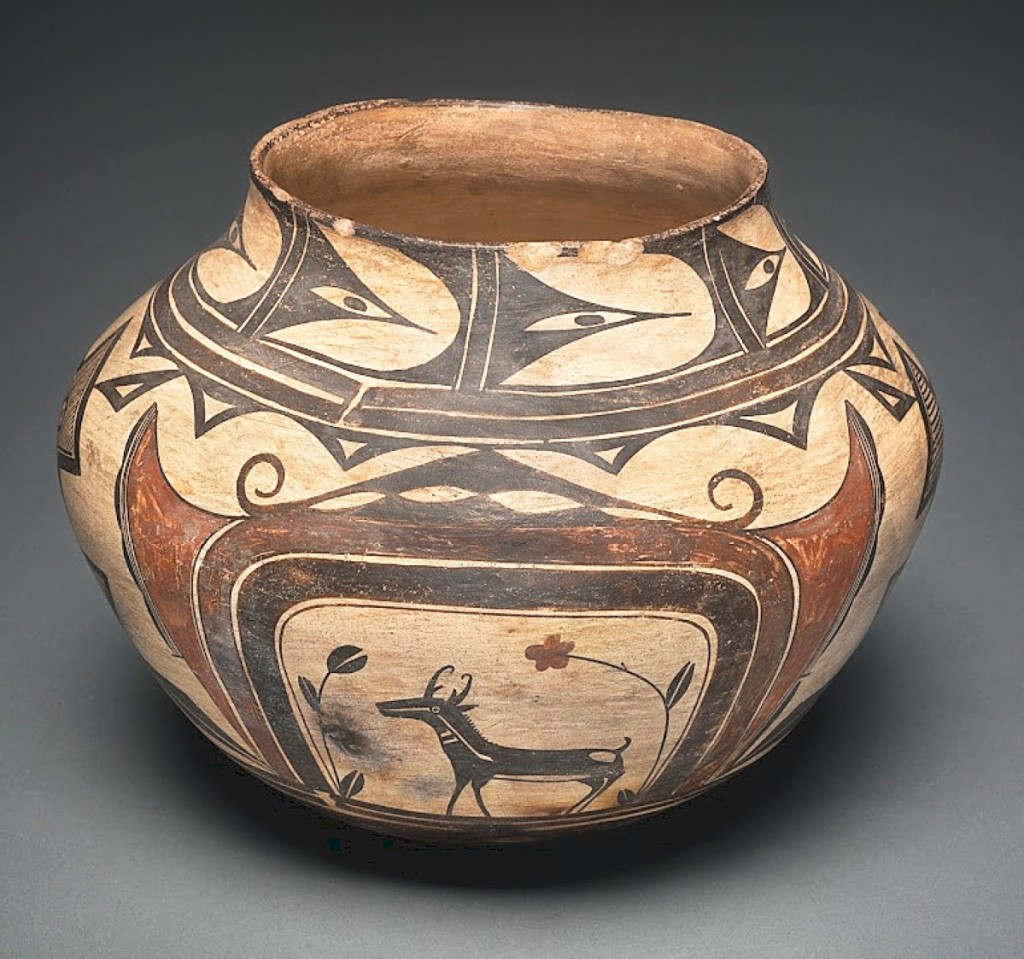
Installation view of “Nampeyo and the Sikyátki Revival,” de Young Museum, San Francisco, 2021. Randy Dodson photo ©Fine Arts Museums of San Francisco.
By Karla Klein Albertson
SAN FRANCISCO – Drawing on its extensive permanent collection, the de Young museum in San Francisco has mounted an exhibition focused on the work of Nampeyo (circa 1860-1942). Skilled as a maker, designer and painter, she is perhaps the best known of all Southwestern potters to whom we can attach a name.
Examples of works with a Nampeyo attribution are treasured by museums and bring astounding prices when they appear on the market. Even during her lifetime when she lived in Hano Village, a Tewa community on Hopi’s First Mesa, now in Arizona, her works were recognized for their beauty and purchased by collectors and anthropologists. Many period photographs exist of the artist with her pottery at various stages of her long life.
On view through February 26, “Nampeyo and the Sikyátki Revival” explores the crucial factors that influenced the potter’s style. As the wall text makes clear:
“Rather than following the contemporary Hopi style, Nampeyo drew inspiration from ceramic sherds found at abandoned ancestral villages near First Mesa, extrapolating the fragmentary designs. One village, Sikyátki, became the focus of an archaeological excavation. The team unearthed large, elaborately painted polychrome vessels made by ancestral Hopi artists in the Fifteenth through Seventeenth Centuries. Nampeyo studied these works, replicating the low, wide jars and adapting the colorful motifs to her own aesthetic. This style, often called Sikyátki Revival, became what outsiders most commonly associate with Hopi pottery. Nampeyo passed her knowledge on to her daughters, who in turn taught their daughters, an artistic legacy Nampeyo’s descendants continue today.”
![“Nunipayo, [i.e. Nampeyo] decorating pottery” by Edward S. Curtis (American, 1868-1952) circa 1900. Photographic print, Library of Congress Prints and Photographs Division, Lot 12315, control number 2003652744.](https://www.antiquesandthearts.com/wp-content/uploads/2022/04/nampeyo_curtis-1024x799.jpg)
“Nunipayo, [i.e. Nampeyo] decorating pottery” by Edward S. Curtis (American, 1868-1952) circa 1900. Photographic print, Library of Congress Prints and Photographs Division, Lot 12315, control number 2003652744.
In an interview with Antiques and The Arts Weekly, Olcott talked about the inspiration for the show: “I thought this would be an incredible opportunity to feature the Fine Arts Museums’ collection of Hopi pottery. We have this beautiful, rich collection, and we don’t often have the opportunity to bring important pieces out of storage and into our galleries. We have Nampeyo’s work, of course, but then we also have wonderful examples of ancestral Hopi ware, the Sikyátki style pottery that she was inspired by. It’s not often that they’re such beautiful and complete examples.”
She continued, “The other inspiration for the project was the gift we received in 2013 from the Thomas W. Weisel Family Collection. I am currently working on a catalog of the entire collection, which is scheduled to be published in the fall of 2022. We have more than 80 authors involved, about 100 full-page plates, and a full catalog of the collection – we’re very excited.
“I’ve been working closely with the objects, and I became acquainted with Bobby Silas, one of the authors of the book. He is an incredible Hopi potter who is working on reviving ancestral pottery styles and techniques. His insight offered a real richness to the project.”

Jar, Hopi, 1890-1900. Earthenware and pigment, 10-1/16 by 13- 3/8 inches. Gift of the Thomas W. Weisel Family to the Fine Arts Museums of San Francisco, 2013.76.34. Randy Dodson photo ©Fine Arts Museums of San Francisco.
The curator emphasized that Nampeyo was not only a skilled potter – making difficult smooth elongated ovals using a coiled clay technique – but also a brilliant designer and painter: “The designs are beautifully laid-out, very balanced. The majority of potters lay out the designs in pencil, but Nampeyo didn’t do that. She free-handed her designs, and that’s one way you can tell a Nampeyo work – by the really fine, confident, and steady brush strokes, particularly of the black outlining.”
As visitors view the exhibition over its long run, Olcott concluded: “I hope visitors leave the exhibition with a sense of inspiration and curiosity and a desire to learn more, not just about Nampeyo and her works but also Hopi pottery past and present. The exhibition features pottery that spans more than 600 years of Hopi history and demonstrates this incredible creativity and skill and ingenuity of generations of Hopi artists. While Nampeyo was a very influential artist in her own right, especially when female artists weren’t always recognized, she’s also part of a larger tradition of pottery making that has gone on for centuries and continues today.”
One of the Fine Arts Museums of San Francisco, the de Young Museum is in Golden Gate Park, at 50 Hagiwara Tea Garden Drive. For more information, www.deyoung.famsf.org or 415-750-3600.
[Editor’s note: A new book by Edwin L. Wade and Allan R. Cooke. The Call of Beauty: Masterworks by Nampeyo of Hopi. Sedona, AZ: El Otro Lado Press, in association with Western Spirit: Scottsdale’s Museum of the West. 2022 is now available at the museum shop at Scottsdale’s Museum of the West, at https://www.shop.scottsdalemuseumwest.org/product-page/the-call-of-beauty]

















